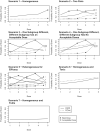Subgroup-specific dose finding for phase I-II trials using Bayesian clustering
- PMID: 35429178
- PMCID: PMC9324955
- DOI: 10.1002/sim.9410
Subgroup-specific dose finding for phase I-II trials using Bayesian clustering
Abstract
In most models and algorithms for dose-finding clinical trials, it is assumed that the trial participants are homogeneous-the optimal dose is the same for all those who qualify for the trial. However, if there are heterogeneous populations who may benefit from the same treatment, it is inefficient to conduct dose-finding separately for each group, and assuming homogeneity across all subpopulations may lead to identification of the incorrect dose for some (or all) subgroups. To accommodate heterogeneity in dose-finding trials when both efficacy and toxicity outcomes must be used to identify the optimal dose (as in immunotherapeutic oncology treatments), we utilize an adaptive Bayesian clustering method which borrows strength among similar subgroups and clusters truly homogeneous subgroups. Unlike methodology already described in the literature, our proposed methodology does not require the assumption of exchangeability between subgroups or a priori ordering of subgroups, but does allow for specification of different subgroup-specific priors if prior information is available. We provide a comparison of operating characteristics between our method and Bayesian hierarchical models for subgroups in a variety of relevant scenarios. After simulation studies with four a priori subgroups, we observed that our method and the hierarchical models both outperform separate subgroup-specific models when all subgroups have the same dose-efficacy and dose-toxicity curves. However, our method outperforms hierarchical models when one subgroup has a different dose-efficacy or dose-toxicity curve from the other three subgroups.
Keywords: Bayesian model averaging; dose-finding clinical trial; spike-and-slab prior; subgroup.
© 2022 The Authors. Statistics in Medicine published by John Wiley & Sons Ltd.
Figures

Similar articles
-
Adaptive Bayesian information borrowing methods for finding and optimizing subgroup-specific doses.Clin Trials. 2024 Jun;21(3):308-321. doi: 10.1177/17407745231212193. Epub 2024 Jan 19. Clin Trials. 2024. PMID: 38243401 Free PMC article. Review.
-
Subgroup-specific dose finding in phase I clinical trials based on time to toxicity allowing adaptive subgroup combination.Pharm Stat. 2018 Nov;17(6):734-749. doi: 10.1002/pst.1891. Epub 2018 Aug 15. Pharm Stat. 2018. PMID: 30112806 Free PMC article.
-
A simulation study of methods for selecting subgroup-specific doses in phase 1 trials.Pharm Stat. 2017 Mar;16(2):143-156. doi: 10.1002/pst.1797. Epub 2017 Jan 23. Pharm Stat. 2017. PMID: 28111916 Free PMC article.
-
Two-stage subgroup-specific time-to-event (2S-Sub-TITE): An adaptive two-stage time-to-toxicity design for subgroup-specific dose finding in phase I oncology trials.Pharm Stat. 2022 Nov;21(6):1138-1148. doi: 10.1002/pst.2231. Epub 2022 May 12. Pharm Stat. 2022. PMID: 35560864
-
Bayesian cancer clinical trial designs with subgroup-specific decisions.Contemp Clin Trials. 2020 Mar;90:105860. doi: 10.1016/j.cct.2019.105860. Epub 2019 Oct 31. Contemp Clin Trials. 2020. PMID: 31678411 Review.
Cited by
-
Adaptive Bayesian information borrowing methods for finding and optimizing subgroup-specific doses.Clin Trials. 2024 Jun;21(3):308-321. doi: 10.1177/17407745231212193. Epub 2024 Jan 19. Clin Trials. 2024. PMID: 38243401 Free PMC article. Review.
References
-
- Le Tourneau C, Dieras V, Tresca P, Cacheux W, Paoletti X. Current challenges for the early clinical development of anticancer drugs in the era of molecularly targeted agents. Target Oncol. 2010;5:65‐72. - PubMed
-
- O'Quigley J, Paoletti X. Continual reassessment method for ordered groups. Biometrics. 2003;59(2):430‐440. - PubMed
-
- Cunanan KM, Koopmeiners JS. Hierarchical models for sharing information across populations in phase I dose‐escalation studies. Stat Methods Med Res. 2018;27(11):3447‐3459. - PubMed
-
- Cunanan KM, Koopmeiners JS. Efficacy/toxicity dose‐finding using hierarchical modeling for multiple populations. Contemp Clin Trials. 2018;71:162‐172. - PubMed
MeSH terms
LinkOut - more resources
Full Text Sources
Medical
